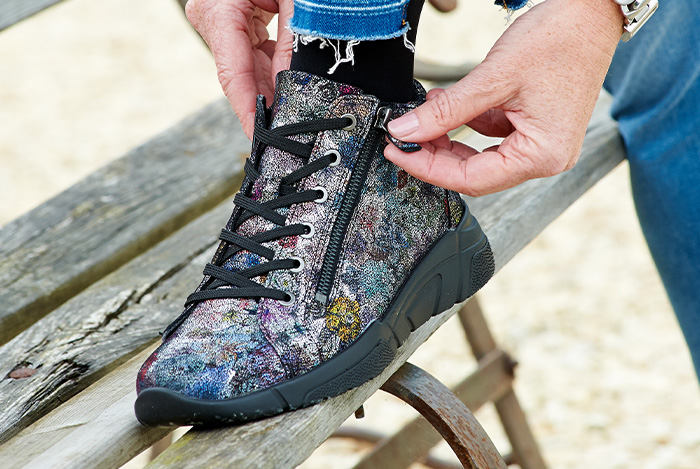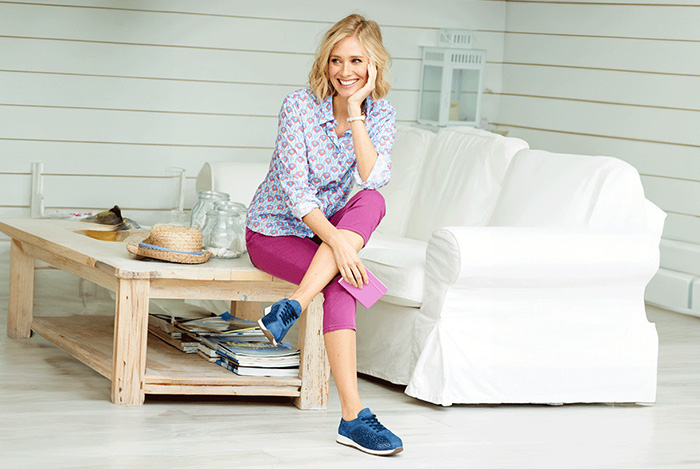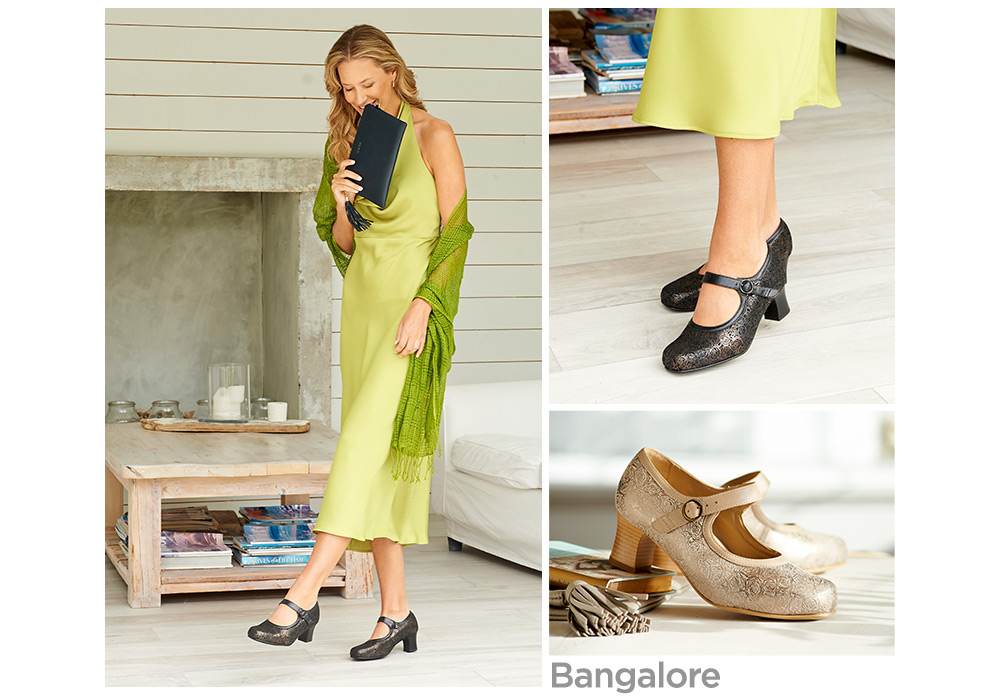We use cookies to make your experience better. To comply with the new e-Privacy directive, we need to ask for your consent to set the cookies. Learn more
Five Reasons Your Feet Change Shape and What You Can Do About It
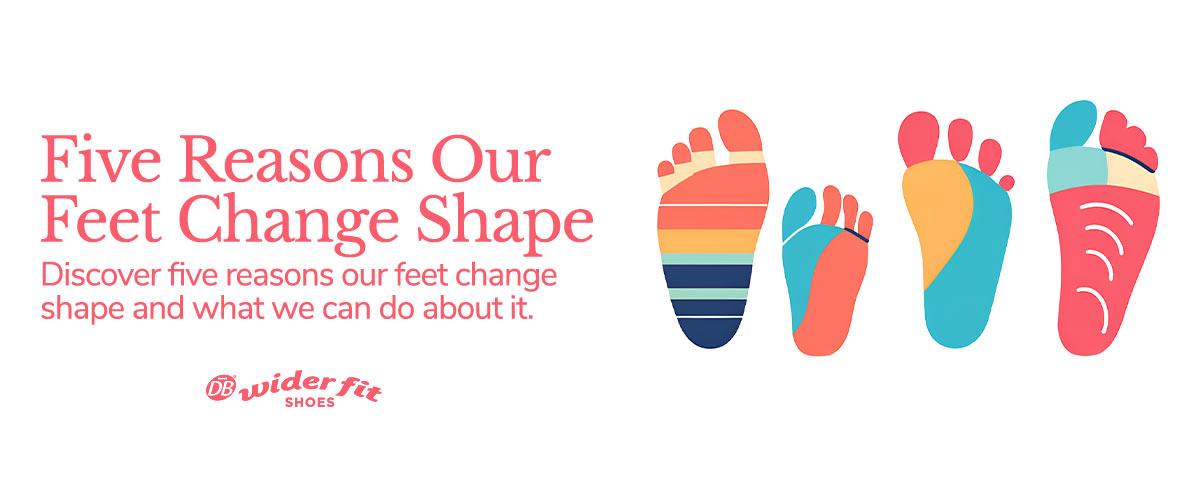
Your feet are the foundation of your body, supporting your weight and enabling movement. They carry us in our daily lives and are often under-appreciated.
However, they are not immune to change. Over time, factors like age, lifestyle, life-events and health conditions can alter their shape. Recognising these changes and addressing them early can help you avoid discomfort and potential health issues.
We take a look at why feet change shape, what issues this can cause, how to check for changes, and what steps to take if you notice differences.
NEW TO OUR SHOES? Find out more about how we can help!
1. Aging and Natural Wear and Tear
As you age, your feet undergo several physiological changes. The ligaments and tendons in your feet lose elasticity, causing your arches to flatten. This can make your feet appear longer or wider.
Additionally, the natural padding on the soles of your feet diminishes, which may lead to discomfort when walking or standing for extended periods.
Issues Caused:
- Flattened arches can lead to overpronation (excessive inward rolling of the foot), which may cause knee, hip, or back pain.
- Thinner foot padding can increase sensitivity and the risk of foot pain or calluses.
What You Can Do:
- Regularly stretch and strengthen foot muscles to maintain flexibility.
- Invest in supportive shoes with cushioned insoles to replace the lost padding. Many of our shoes, like modern sporty boot Harbour, feature 2 x removable cushioned insoles and an air-bubble flared wedge sole for extra cushioning.
- Consider custom orthotics for additional arch support. All of our shoes are wider and deeper than high street shoes and many come with removable insoles that you can replace with your own specialist insole.
For a closer look at how aging can affect your feet read Six Ways Our Feet Change as We Age.
2. Weight Changes
Gaining or losing a significant amount of weight can impact the shape of your feet. Increased weight changes the mechanics of our body and feet, adding different stresses for your feet.
Additionally, increased weight can lead to reduced blood circulation, which can lead to swelling in the feet and ankles.
Conversely, rapid weight loss can reduce the fat pads in your feet, leading to a thinner appearance and less natural cushioning.
Issues Caused:
- Reduced circulation can result in swollen feet and ankles, which can often be painful
- Increased pressure on the arches can lead to plantar fasciitis, a condition that causes heel pain.
- A thinner foot structure can make walking or standing for long periods uncomfortable.
What You Can Do:
- If gaining weight, choose footwear with excellent arch support and shock absorption. Remain active to maintain circulation levels.
- Ensure footwear that is wide and deep enough to accommodate your feet without rubbing. Look for adjustable styles and soft materials or shoes with stretch panels like stretch trainer Whitworth to reduce rubbing.
- Look for the Good for Swollen Feet icon in our brochure or on our product pages
- If losing weight, focus on maintaining good foot hygiene to avoid calluses and discomfort from reduced padding.
3. Pregnancy
Pregnancy can significantly alter the shape of your feet due to hormonal changes and weight gain. The hormone relaxin, which helps prepare the body for childbirth, also loosens ligaments in the feet, causing the arches to flatten and the feet to widen.
According to foot specialists at University of Iowa (Segal et al, "Pregnancy Leads to Lasting Changes in Foot Structure"):  Pregnancy appears to be associated with a persistent loss of arch height and rigidity as well as greater arch drop and foot lengthening, and the first pregnancy may be the most significant.
Pregnancy appears to be associated with a persistent loss of arch height and rigidity as well as greater arch drop and foot lengthening, and the first pregnancy may be the most significant.  Issues Caused:
- Flattened arches can lead to overpronation, contributing to joint pain and discomfort.
- Wider – and sometimes longer - feet may require a permanent change in shoe size.
What You Can Do:
- During pregnancy, wear supportive shoes with ample cushioning and arch support, as well as sufficient width to avoid pinching and rubbing.
- Post-pregnancy, consider seeing a podiatrist for custom orthotics if discomfort persists.
- Measure your feet to ensure your current footwear, or any new footwear purchased, is the correct length and width for your needs. Use our Online Fit Finder helpful tips and a handy video demonstrating how to accurately measure your feet. You will need a fabric tape measure to measure around your foot, as well as the length, then simply enter your measurements into the Fit Finder to discover your size and fitting, along with available styles for you.
Issues Caused:
- Flattened arches can lead to overpronation, contributing to joint pain and discomfort.
- Wider – and sometimes longer - feet may require a permanent change in shoe size.
What You Can Do:
- During pregnancy, wear supportive shoes with ample cushioning and arch support, as well as sufficient width to avoid pinching and rubbing.
- Post-pregnancy, consider seeing a podiatrist for custom orthotics if discomfort persists.
- Measure your feet to ensure your current footwear, or any new footwear purchased, is the correct length and width for your needs. Use our Online Fit Finder helpful tips and a handy video demonstrating how to accurately measure your feet. You will need a fabric tape measure to measure around your foot, as well as the length, then simply enter your measurements into the Fit Finder to discover your size and fitting, along with available styles for you.
4. Foot Injuries or Foot-health Conditions
Injuries like fractures, sprains, or strains can alter the shape of your feet over time. Additionally, conditions such as bunions, hammertoes, or arthritis can lead to structural changes.
These changes will alter your footwear requirements, by changing the shape of the toe-box or ankle you require, possibly leading to the need for more depth, or the type of fastening most suited to you.
Possible Issues Caused:
- Bunions (bony bumps at the base of the big toe) can make finding comfortable shoes challenging. Learn more about the best shoes for bunions.
- Hammertoes (abnormal bending of toes) can cause pain and difficulty walking. Learn more about the best shoes for hammer toes.
- Arthritis can lead to joint deformities and stiffness. Discover the best shoes for arthritis.
- Diabetes can cause swelling alongside other changes that make the correct footwear for diabetes sufferers very important indeed.
What You Can Do:
- Address injuries promptly and follow your doctor’s advice for recovery.
- Use protective pads or splints for bunions and hammertoes.
- Look for shoes and boots with the correct features for your foot health condition, such as wide-fitting boot Farnham for bunions or hammer-toes, loafer Mustang for arthritis or leather boot Buckingham for diabetes.
We provide helpful icons alongside all products in our brochure and on our website, alongside product filters so that you can easily find styles that are suitable for your condition. See also our Shoes for Medical Conditions article.
- For arthritis, opt for footwear with soft uppers and roomy toe boxes to accommodate swollen joints, alongside easy strap-fastenings or slip-ons for people with reduced hand motility.
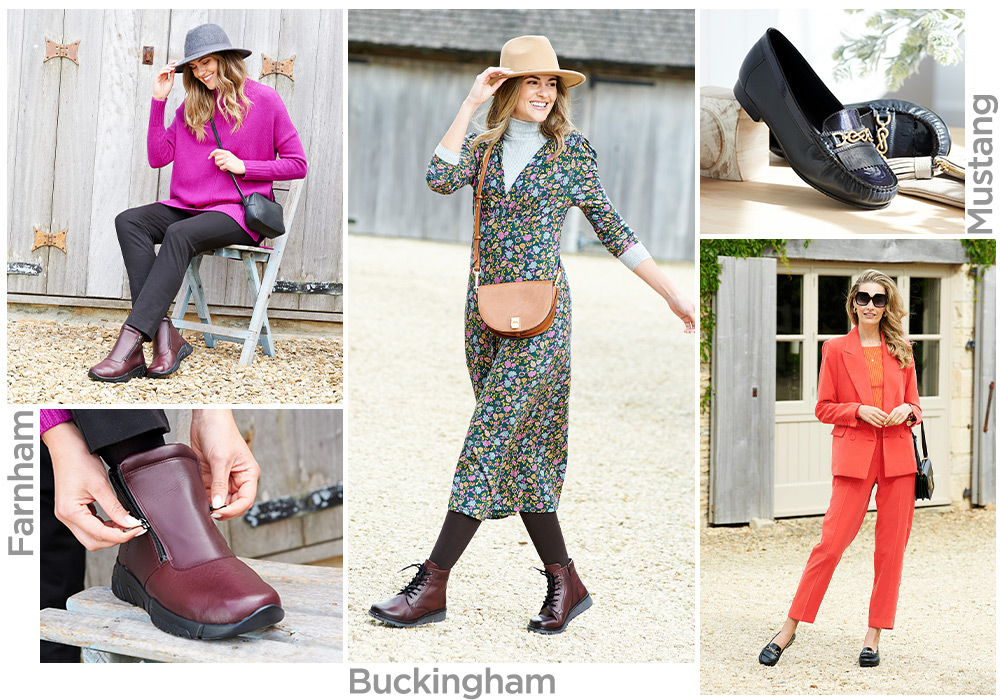
5. Menopause
Menopause brings hormonal changes that can affect the bones, muscles, and ligaments in your feet. Declining oestrogen levels can lead to reduced bone density and elasticity, contributing to changes in foot shape and size. Water retention during menopause can also cause swelling, leading to a temporary increase in foot width.
Our Joyful Strides for Wider Feet ambassador Rebecca told us  My menopause journey really started around the time of the lockdown… when I suddenly started putting on more weight and I found it difficult to shift that. I found that my feet were changing which really surprised me as a result of that weight gain.
So, because of that I didn’t want to wear the kind of shoes that I associated with my parents. I wanted shoes that reflected my own personal style.
My menopause journey really started around the time of the lockdown… when I suddenly started putting on more weight and I found it difficult to shift that. I found that my feet were changing which really surprised me as a result of that weight gain.
So, because of that I didn’t want to wear the kind of shoes that I associated with my parents. I wanted shoes that reflected my own personal style.  She found that with high-top wedge trainer Antelope and Bangalore stretch dress heels. Read Rebecca’s Joyful Strides story.
Possible Issues Caused:
- Reduced bone density increases the risk of stress fractures.
- Loss of ligament elasticity may lead to flattened arches and overpronation.
- Swelling can make shoes feel tight, causing discomfort or blisters.
What You Can Do:
- Invest in shoes with arch support and cushioned soles to reduce strain on bones and joints.
- Avoid restrictive footwear, especially during periods of swelling. Stretch fabrics and soft leathers, like Rebecca’s choice Bangalore are ideal
- Incorporate weight-bearing exercises into your routine to maintain bone health.
- Stay hydrated and reduce salt intake to minimise swelling.
- Consider calcium and vitamin D supplements to support bone strength, as advised by your doctor.
She found that with high-top wedge trainer Antelope and Bangalore stretch dress heels. Read Rebecca’s Joyful Strides story.
Possible Issues Caused:
- Reduced bone density increases the risk of stress fractures.
- Loss of ligament elasticity may lead to flattened arches and overpronation.
- Swelling can make shoes feel tight, causing discomfort or blisters.
What You Can Do:
- Invest in shoes with arch support and cushioned soles to reduce strain on bones and joints.
- Avoid restrictive footwear, especially during periods of swelling. Stretch fabrics and soft leathers, like Rebecca’s choice Bangalore are ideal
- Incorporate weight-bearing exercises into your routine to maintain bone health.
- Stay hydrated and reduce salt intake to minimise swelling.
- Consider calcium and vitamin D supplements to support bone strength, as advised by your doctor.
How to Check If Your Feet Have Changed Shape
1. Self-Examination: Look for visible changes, such as a longer or wider appearance, bony bumps (bunions), or curling toes.
2. Measure Your Feet: Using a Brannock device or a fabric tape measure, check your foot length and width. Ensure you measure both feet, as one foot is often slightly larger. View more helpful tips on how to measure your feet.
3. Observe Shoe Fit: If your usual shoes feel tight or uncomfortable, it may indicate a change in foot size or shape. Ensure you feel for tightness across the top of your foot or pinching at the sides along with pressing of the toe.
Also pay attention to your foot shape. We offer shoes and boots in four different toe shapes to ensure total comfort whatever your foot shape.
4. Pain or Discomfort: Persistent pain, especially in the arches or toes, can signal structural changes.
5. Footprints Test: Step on a piece of paper with wet feet to examine your arch pattern. A flatter print may indicate fallen arches.
What to Do If You Notice Changes
1. Visit a Podiatrist: A professional can assess the extent of the changes and recommend treatments or custom orthotics.
2. Update Your Footwear: Replace your old shoes with ones that accommodate your current foot size and shape. Discover our huge range of wide and extra-wide fitting footwear for women and men.
Measure your feet with a fabric tape measure and use our Fit Finder to discover your size and width requirement for our shoes, then browse the styles available.
3. Use Orthotics: Custom or over-the-counter insoles can provide additional support and address discomfort.
4. Practice Foot Care: Regularly stretch your feet, soak them to relieve soreness, and moisturise to prevent dry skin.
5. Look for shoes for foot health issues: Ensure you consider factors other than simply length and width. Ensure you take into account the design features you need for conditions such as bunions, hammer toes, arthritis, diabetes, lymphoedema, flat feet or plantar fasciitis.
6. Consider Physical Therapy: A physical therapist can guide you through exercises to strengthen foot muscles and improve alignment.
Final Thoughts
Changes in foot shape are common and can occur due to various factors, including aging, weight fluctuations, pregnancy, injuries, and lifestyle choices. While these changes are often natural, they can lead to discomfort and other issues if not addressed.
By regularly monitoring your feet, updating your footwear to ensure suitability for your foot size, shape or medical condition and seeking professional advice when necessary, you can maintain comfort and prevent potential complications.
Your feet carry you through life—take care of them!
Risk free footwear
We know that it’s really difficult to order footwear online and find the perfect fit, but we want to make it as easy, risk-free and stress-free as possible. That’s why we offer free postage on returns and exchanges on all UK orders so that, if you’re in the UK and have ordered from us and the shoes aren’t right for whatever reason, you can give us a call to discuss the problem and return them to us, unworn except for trying on to exchange for a different size, style or fitting without paying a penny more in postage.
Once you’ve found your perfect fit, you’ll never look back!
We hope that you agree that our wide-fitting shoes, trainers and sandals offer the perfect fit for every wide, deep or problem foot!
VAT Exempt footwear
Did you know, if you need 6E, 6V or 8E fitting footwear and have a qualifying condition, that you might be eligible for VAT relief?
This means that you could essentially benefit from a discount of 20%. And what's more, our promotional discount codes still apply, meaning you can gain further savings.
We make it easy to claim your VAT relief by clearly listing the VAT exempt price against qualifying products, and provide a very short form to fill out as part of the checkout process when ordering your 6E, 8E or 6V fitting shoes.
Qualifying conditions for VAT free purchases include physical or mental impairment that affects your ability to carry out everyday activities, for example, blindness; conditions treated as chronic sickness, such as diabetes, arthritis or lymphoedema; and long-term illnesses.
Look out for the link underneath our available fittings on each product page to claim your VAT exemption.
Need Our Help?
If you’re unsure about anything at all to do with our styles, features or fittings and whether they’re right for you, please do contact us on +44 (0)1933 311 077, Monday to Friday, 9-5 to speak with one of our friendly, knowledgeable UK based customer services team, who will be delighted to help.
OR would you like some in-person help to find the perfect fit for your feet? Then why not book an appointment and visit our Fitting Centre in Rushden, Northamptonshire.
We offer a traditional, personal service to help you find the perfect shoes either for naturally broad feet, to accommodate orthotics and or for foot health issues such as arthritis, lymphoedema, diabetes, bunions and many more.
Our appointment system ensures you'll receive our team's full attention and there's no obligation to buy.
Check out our Fitting Centre details today for further information.
Why not check out some of our other blog posts to help you with you find your perfect shoe.
Best Shoes for Diabetes »
The Best Shoes for Arthritis »
Shoes for Oedema and Lymphoedema »





